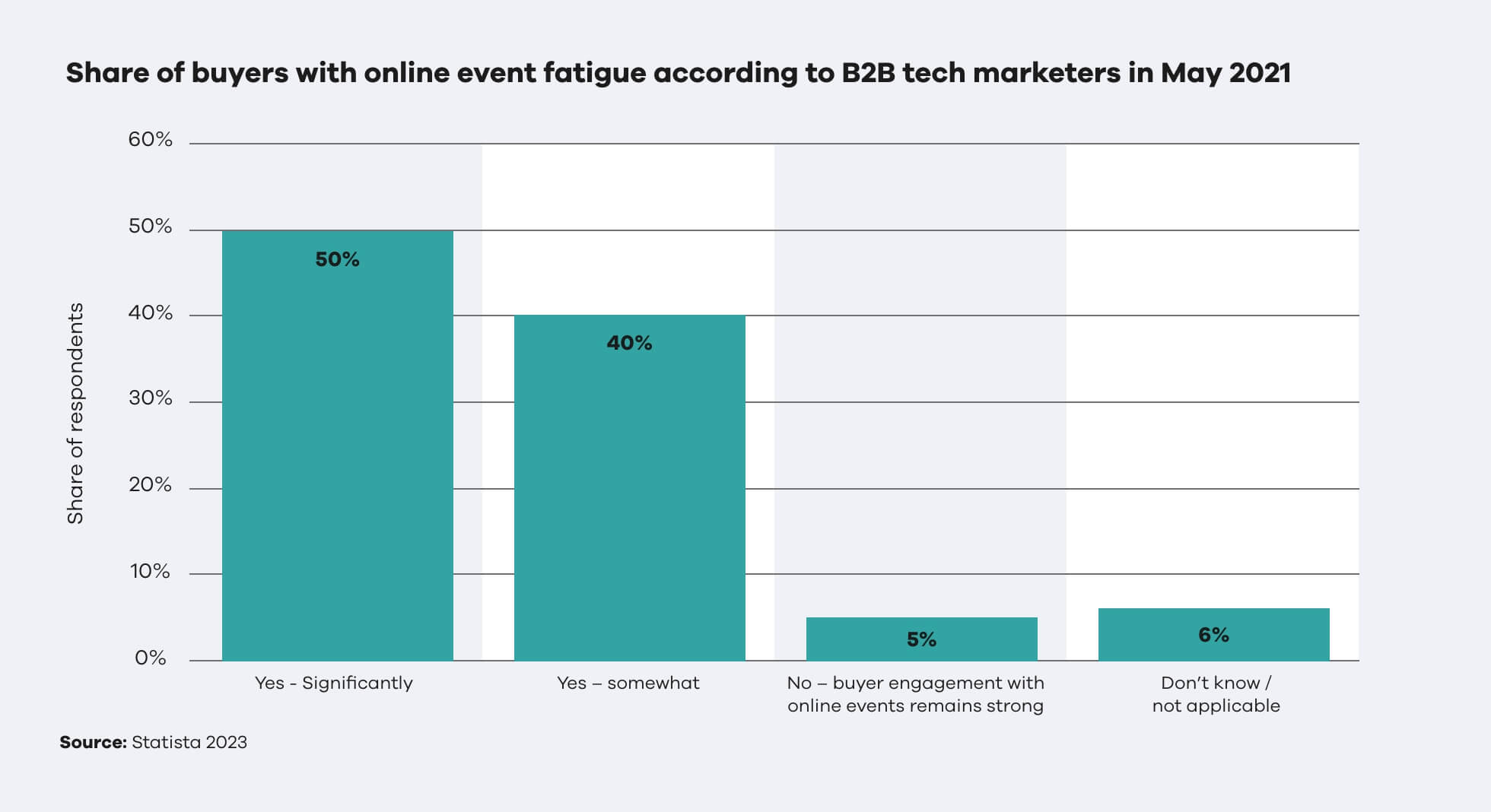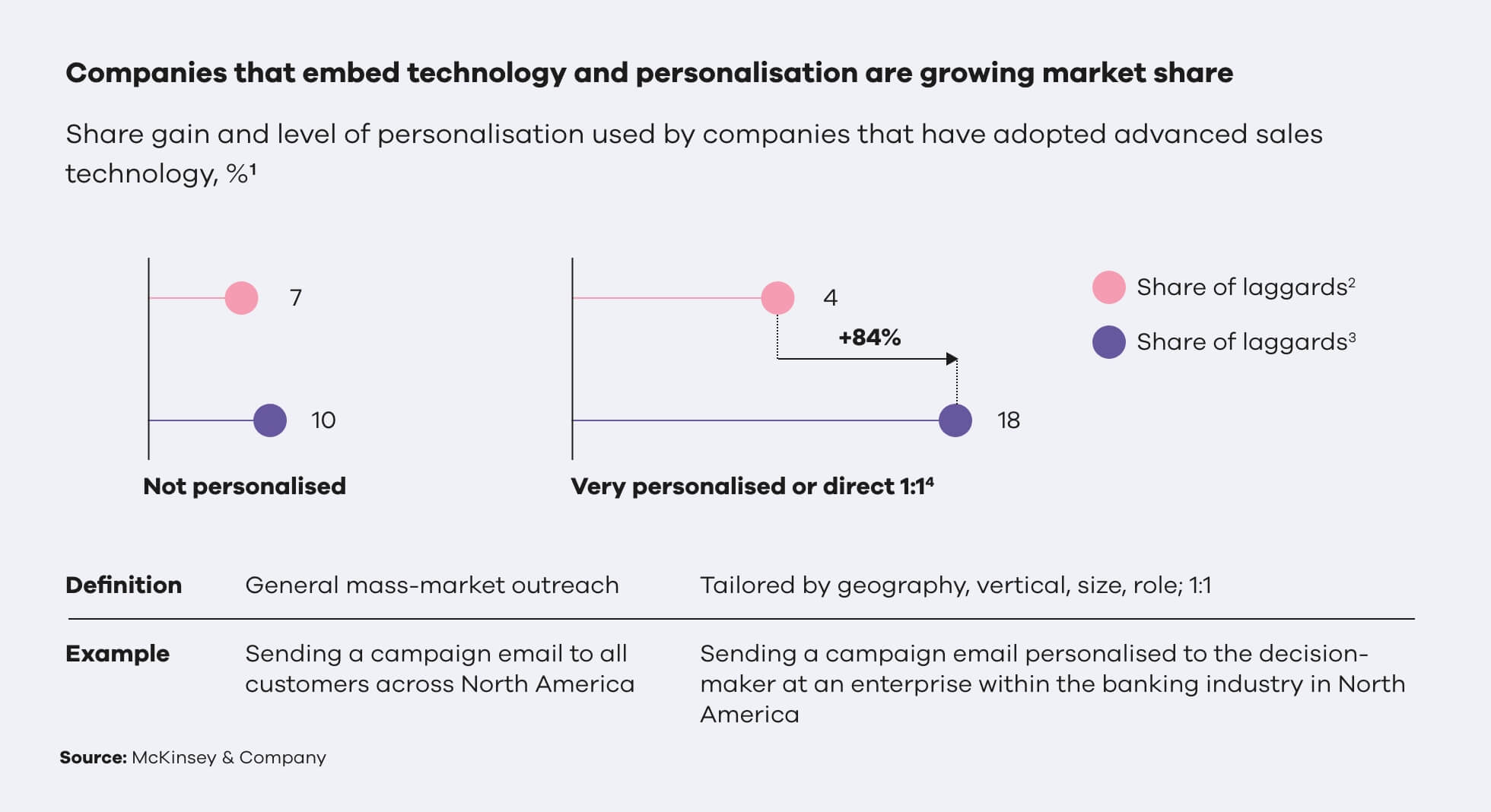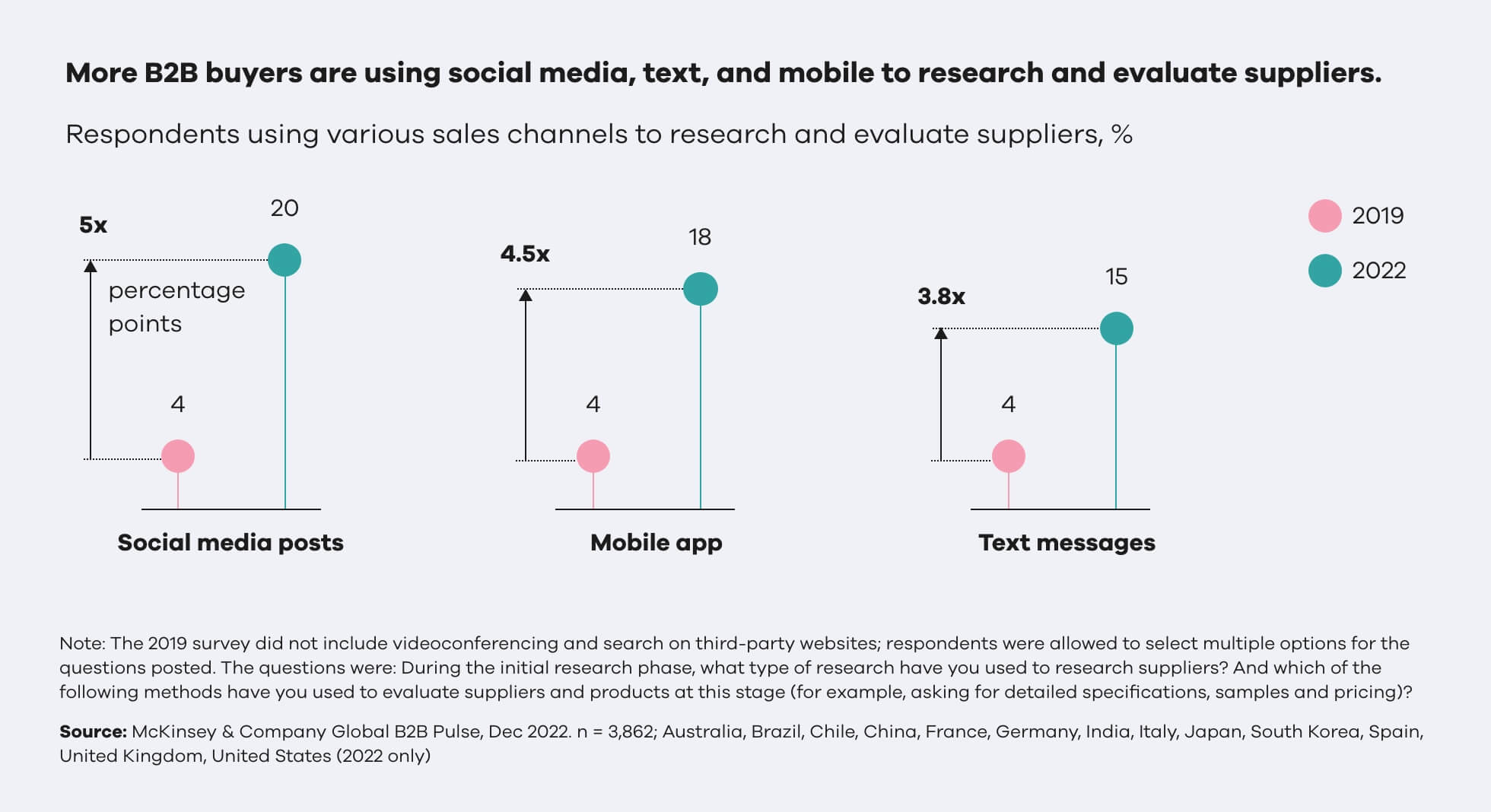The end of B2B marketing as we know it: How traditional comms are being replaced by communities
Sam Bettis, krow.x’s Customer Engagement Director, shares the trends driving the future of B2B marketing – and how marketing teams and businesses can make the most of them.
Every new B2B marketing contract is a high-stakes decision for the buyers involved. Will they meet, beat or miss sales targets? Will a new process change the game or disrupt the flow? Will the business ultimately thrive or lag behind?
The weight of these decisions is just one of many reasons why the traditional B2B ‘sales journey’ needs to evolve, encompassing more stakeholders and touchpoints than just the marketing team’s remit. From changes driven by technology and markets to audience lifestyles, in this report we’ll explain how and why B2B communications are shifting towards a community focus, in terms of how they’re both produced and consumed.
And, most importantly, we’ll take a closer look at the trends and opportunities to leverage if you’d like to build better value-added corporate experiences over the next five years.
HOW TO USE THIS REPORT
This report explores five key future B2B marketing trends. For each trend, we discuss what it can look like for different businesses, and considerations when putting it into practice.
At the end of this document, we’ve created a checklist for each trend so you can take away the essential points to refer to at a glance.


The context: Why traditional B2B marketing isn’t working
The traditional mix of B2B marketing content and channels has struggled to keep up with the changing nuances and realities of customer journeys, often failing to incorporate newer and better ways of working, such as using better self-serve models and smart tech, and broadening channel footprints and impacts.
At the same time, department silos and their differing (and sometimes conflicting!) objectives mean focus is placed on the wrong metrics – for example, marketing teams filling funnels while sales teams attempt to build relationships.
Add to this the confusion over the best creative execution and tone to strike: the recent trend of treating B2B marketing like B2C has created content which lacks depth and feels strategically short-term. On the other hand, treating B2B marketing as stereotypically B2B can produce boring work which blends into the category noise, missing the opportunity to connect with the person behind the job title.
Lastly, combine these factors with changing technology, skillsets, workplaces, expectations and disruptions… it’s pretty overwhelming, isn’t it?
In this context, it’s clear to see why a reset moment is coming and why we need to ask ourselves what ‘B2B marketing’ really means in the here and now. As a minimum, bad practices need an overhaul. But, taking a more revolutionary approach, you could argue the category needs to be reconsidered from the ground up, or even no longer exists in its traditional form – an idea we explore in the next section.
The emergence of communities is driving change
Looking closer at what’s going on within businesses, the procurement of new tools, solutions and ideas is a shared responsibility and experience that increasingly involves a community of people. These workplace communities are trying to do great things, make improvements and drive growth. Emotionally they have ambition and an appetite for risk, while at a strategic level there’s a strong commercial case for change.
To achieve these big goals, B2B marketers need to stop asking ‘what should we say and where?’, and instead ask ‘how can we help?’. Instead of delivering a suite of comms within a plan, we need to build experiences that create value for corporate audiences and build their networks.
This need for change and the shift towards experiences and communities is driven by various factors, such as:
- Options overload
B2B decision-makers are faced with more choice than ever, fuelled by the growth of niche solutions and startups. It’s now more of a challenge to procure the right solutions in the right order.
- Solutions offering team value
With more advanced tech available than ever before, B2B solutions need to feel like a natural extension of the team if they’re going to make a real difference to day-to-day working lives. How can this be achieved? By focusing on building value in training, support and new experiences.
- A new generation
A new generation of B2B decision makers shaped by modern technological experiences are coming into the workplace and need richer, digital-first ways to simplify decision-making.
- Everything’s global
With the rise of remote and hybrid working – 40% of UK employers now offer a hybrid working model – global thinking is creating new ways of offering value in the B2B space, and marketers need to understand their niche in several markets.
This emerging focus on experience and community is why this report opens with the bold claim that B2B marketing as we know it is coming to an end. In the following section, we’ll look at the trends proving and accelerating this shift, and how to adopt them to create your own corporate value experiences.


TREND 1: HYBRID LIFE
We’ve known since 2020 that B2B marketing was never going to be the same. The rate of tech transformation within corporate life is unprecedented – you only have to remember that pre-2020 many businesses operated with only a small handful of bookable conference lines and rarely a video call in sight.
While this change occurred as an inevitable consequence of lockdown, hybrid life can be transformational to relationship management and creating great experiences if embraced in the right way. For example:
- Hybrid events
Hybrid events don’t just merge digital and physical attendees, but also present the opportunity to deliver better personalisation by combining data across sources. Adobe provides a great example of a considered approach to hybrid events, using first-party data to delight all attendees. A true win-win, remote guests got the same personalisation, while in-person attendees still benefitted from efficient connections.
- Immersive experiences
That’s a pretty compelling stat, highlighting why hybridity is important. With this in mind, we need to think about how we can bring more immersive moments into the B2B buying cycle. Metaverse technology could enable connection in ways we never thought possible, like sitting down in virtual conference rooms and even having videoconferences in Roblox!
- A new approach to relationships
89% of B2B buyers would pay a premium for excellent service. This service could be in-person or digital, so the true key to success is personalisation throughout the experience to deliver meaningful connections. Using hybridity to enhance relationships and focus on the moments that matter could help redefine how to add value in B2B marketing.
Aligning all three of these hybrid opportunities within B2B marketing would provide optimum value and put technology to work where it performs best, answering the question we touched on earlier of ‘how can we help?’. The opportunity to do great things in hybrid corporate experiences is an exciting prospect, however the considerations below are key to making it happen.
“In the evolving world of B2B, the pivotal shift towards hybrid interactions demands a thoughtful embrace of technology. By seamlessly blending physical and digital realms, we unlock the power to craft personalised immersive experiences that redefine value, transforming relationships and reshaping the very essence of corporate engagement.”
Emma Osborne, Senior Client Partner at krow.x
Considerations for hybrid corporate experiences
- Understand regional differences
Hybrid experiences aren’t one-size-fits-all. Focus on personalised, scaled experiences. Prioritise the right way to connect and ensure the tech can deliver.
- Give people the choice
The thing that makes technology great is the flexibility it provides, allowing people to choose a channel, device and format to suit their needs. When creating hybrid experiences, don’t see them as purely a cost-cutting exercise; deepen relationships by offering choice.
- Have the right technology
Hybrid experiences fly or flop based on what’s powering them, so explore tech in advance and be clear on what you want to achieve. This doesn’t mean a huge investment every time – there are plenty of low-cost platforms that can facilitate excellent experiences.
- Make it personal
Just as tech shouldn’t be viewed as cost-cutting, avoid the temptation to mass-produce. Hybrid experiences should focus on the parts of the relationship that matter most, so carry out empathy mapping to figure out what B2B audiences really need.


Trend 2: Blended realities
Work and play are blending in more ways than ever. More of us are adopting a hybrid working life, creating home offices, listening to business podcasts for fun and enjoying brands such as SEMrush on TikTok.
By embracing the concept of blended realities, we can start to see a great story as a great story, and an exciting idea as an exciting idea – whatever form or channel it takes. This approach creates an environment where B2B marketing can adopt the same attention-grabbing tactics as other categories and create experiences that truly connect. (Or, to put it another way, B2B shouldn’t be viewed as something that starts and ends on LinkedIn.)
Rather than pushing against the trend, celebrating the fact that audiences are being entertained and learning at the same time can only elevate creative outputs:
- Embrace attention tactics and mischief
Digital is overstimulating, so audiences respond well to simple, human content. Embracing fun in content creation is a surefire way to make an impact and be memorable. For example, it can be unexpected for B2B marketing to show humanised, behind-the-scenes content.
- Creator content
75% of B2B strategies are starting to invest in creator content. In an era of fandom and micro cultures, finding your ‘tribe’ can be the key to cut-through.
- Customer spotlight
By representing customers and putting them at the heart of stories celebrating success, marketing teams can create something more compelling than corporate case studies. Collaborative content and editorial approaches can add value and diversity to stories – something Easol do beautifully.
B2B marketing needs to do more to connect in blended worlds to rise above the category noise and give audiences quality content – below are the considerations that will help make this happen:
“Recognising the dual landscape of B2B audiences, where professional and personal spheres seamlessly intertwine, underscores the imperative for content creators to craft messages that resonate not only in the boardroom but also within the private spaces of home. Understanding how content is consumed in both work and personal environments, and mastering the telling of true human stories, is the key to unlocking meaningful connections that transcend the boundaries of business, fostering engagement that speaks to the holistic nature of modern professionals.”
Kirstin Wilson, Group Client Partner at krow.x
Considerations for blended realities
- Think like a brand
Over half (62%) of B2B marketing campaigns still prioritise product promotion over brand building (37%), a study by WARC has found. It’s essential to remember corporate audiences are still people, and therefore receptive to emotional connection.
- Connect outside of work
Remember, audiences are not always at work when consuming content. It’s no longer considered ‘unprofessional’ for businesses to be fun beyond the workplace, so marketers need to consider the context of the experience at the heart of every brief.
- Connect with your people
To connect at a human level, we need to tell human stories, embrace change and listen to the things that matter to audiences. This approach shouldn’t be reserved purely for B2C brand-level campaigns – as long as B2B content is relevant and useful to the audience there’s no need to hold back on creative execution.


Trend 3: Valuable interactions
B2B content strategy 101 is making a whitepaper, circulating it and then handing the reins over to the sales team. While this may be effective at times, it’s fuelling B2B fatigue, as shown in the chart below.


Talk of ‘best-in-class B2B’ is creating a one-size-fits-all mindset, often undermining and drawing attention away from the idea of creating valuable interactions. We need to stop asking what a good communication strategy is, and instead ask how we can help and captivate audiences. Techniques can include:
- We’re all teachers
To create value-rich corporate engagement, we need to embrace the idea that we’re all teachers. Creating academy-type environments has been key to customer engagement with many B2B strategies in software-as-a-service (SaaS) models, such as Salesforce Academy and Brandwatch Academy. As B2B marketing is essentially about growth at its core, this knowledge-sharing should form part of everything we do.
- Solutions over content
To provide real value to corporate audiences, it’s helpful to think about solutions rather than just sharing content. For example, Watson Farley & Williams’ GARI tool helps audiences to solve complex problems around aviation leasing, rather than focusing just on being thought-leading – this helpful, award-winning content has driven commercial success.
- Everything is a service
Offering genuinely useful trials is a great way to deliver value – think ‘freemium’ services rather than content. For example, WeTransfer, Atlassian and Dropbox can all be accessed for free, gaining internal traction before moving into an enterprise level by offering real value and growing with businesses.
Focusing on valuable interactions may seem obvious, and many businesses feel like it’s something they’re already doing. However, by reframing the way they go –to market, better and more effective routes may be discovered.
“In today’s multi-channel world, client relationships are more crucial than ever. Listening becomes paramount amidst the noise. Our clients’ personal growth and self-development are intertwined with their perception of success. As their marketing agency, we go beyond the transactional partnership, supporting their business while also fostering personal growth. This approach strengthens our relationship and allows us to provide comprehensive support in various ways.”
Jemma Marchant, Deputy Managing Director
Considerations for creating valuable interactions
- Lead with a value objective
Instead of leading with only a communications and commercial objective, consider building in a value objective. Something formed around what will really help the audience will lead to stronger results.
- Listen carefully
To understand how to add value, marketing teams need to establish feedback loops with audiences and build them into everything they do. To embed a value-offering culture, businesses should establish a ‘voice of the customer’ engagement programme.
- Understand your growth role
A key way to add value for an audience is to understand your business’s role in the growth of each individual – from their lifelong career to improving their day-to-day. Figuring out what you’re helping them achieve should form the basis of interactions and any educational tools and content.
Trend 4: Actionable data
As technology has advanced over time, so has the onus on data. Corporate experiences are increasingly data-driven and measured, with platforms such as LinkedIn championing their ability to offer marketing teams more data than ever. Couple this with increased automation and it’s easy to see how fully automated solutions and lead generation are becoming the norm.
However, the bubble may be about to burst. We’re moving into a cookie-free world, yet less than 8% of marketers are futureproofing their approach. And, on top of this, data is at risk of losing its meaning when it’s viewed more as a quantity-driven KPI than a source of growth and optimisation.
For corporate engagement to thrive, we need to think beyond measurement as a KPI and see it as a tangible, actionable way to listen, grow and talk about audiences – and you’ll be pleased to know there are plenty of opportunities you can leverage to do exactly that:
- Customer metrics
It’s possible to build strategies where data is used to continually get to know customers better. By moving beyond performance and embracing feedback metrics, businesses can optimise their offerings. For example, 62% of B2B customers would spend more after a positive experience – potentially more promising than even the lowest cost per lead.
- Embrace a measurement culture
By avoiding limiting data to a siloed department, businesses can benefit from every employee having access to and understanding data. In some case studies, EBITDA has grown from 15% to 25% when data is adopted correctly.
- Smart flow planning
Automation has been a focus within B2B marketing for some time, but AI and machine learning technologies are making it a more powerful force than ever. As the data below demonstrates, an article by McKinsey highlights the opportunities of automation, explaining how AI can help to create smarter flows with real-time data, deliver competitive offers, close deals at the right time and create better offerings.


To start creating a real impact with actionable data, businesses should consider three core areas, as shown below.
“We’re seeing some of our biggest clients prioritise data as a key pillar in their propositions. Data is invaluable if you use it in the right way, but so many organisations just aren’t using it to its full potential. It can help you build a full picture of who your customer is, what they’re spending on and why and their interests to enable brands to create personalised offers and experiences.”
Lisa Harris, Senior Client Partner
Considerations for actionable data
- Understand silos
The benefit of building data and measurement into the fabric of a business shouldn’t be underestimated – it can be truly transformational. The first place to start is understanding the existing departmental silos that hold the business back from using data in smart, actionable ways. We’d suggest starting with a discovery process, mapping out what is what across departments.
- Quit the performance
Teams can get easily stuck in the mindset of seeing data purely as evidence of performance, and a reason for a pat on the back. Breaking this association and viewing data as a through-the-line growth tool rather than an end result indicator can be a catalyst for change.
- Lead with personalisation
Instead of asking ‘how can I automate?’, ask ‘how can data make communications better and more relevant?’. This is another simple mindset shift that can yield powerful business results.


Trend 5: Meaningful networks
Corporate decision-making is happening across different channels more than ever, from social communities to specialist applications, and even the use of text message groups and peer-to-peer moments. This trend shows that community is important, and great corporate engagement is an opportunity to facilitate it.


While it feels a dated reference, the thing which made WeWork great was how it brought people facing the same challenges together to collaborate and achieve impressive things. Similarly, many of us often feel most productive when talking things through with clients, colleagues and friends – something that feels forgotten in traditional B2B marketing. Imagine if at events, instead of moving people from one sales pitch to another, we facilitated genuine connection?
Meaningful networks can be formed in many ways, but the point is not how to enable networking, but how to enable deeper human connection. For example:
- Self-serve experiences
Only 20% of B2B buyers ever want to speak to a salesperson again. By offering self-service and sparing people the interactions they don’t want to have, can we enhance the value of human interactions elsewhere in the B2B customer journey?
- Community forums
Organisations offering professional services such as AIHR can offer enormous value through community, allowing members to share stories of professional challenges.
- Finding your position of value
Being in a meaningful network doesn’t always mean being the voice of authority. By accepting the position of service user rather than owner, businesses can open themselves up to exciting and valuable collaborations – for example Barclaycard Payments partnered with FT Longitude to conduct research with 500 senior business leaders to understand their strategies, aims and ambitions in the payments space.
Meaningful networks, when understood and used effectively, can transform the relationships between businesses and their B2B customers. See below for the key considerations to getting it right.
“Effective decision-making spans diverse channels, from social communities to specialised applications. True excellence is found in fostering engagement and collaborative spirit, as we saw with Barclaycard Payments. Meaningful networks transcend traditional boundaries, blending self-serve efficiency with a human touch to curate enriching corporate experiences.”
Lisa Harris, Senior Client Partner at krow.x
Considerations for building meaningful networks
- Connect at the right time
Decision-makers are busy people, so it’s important to research when and where to create a meaningful network. Conducting gap analysis to understand the unique opportunities and needs for communities is advisable, but don’t be too niche – you may need to think about how your particular challenge, product or service fits into a wider experience – and, therefore, a wider conversation.
- Identify the things you don’t want to do
To avoid wasted effort and turning B2B audiences off, start by figuring out what can be placed into self-serve, saving human value for where it really matters.
- It’s not a content strategy
Content strategy is a dangerous term in networking, as it can lead to a broadcast comms mindset. Instead think in terms of themes, and the type of network you’re aspiring to create.
In summary: community-driven corporate experiences are the way forward
As we head into 2024 and beyond, businesses will need to embrace the transformative shift from communications to communities to remain relevant. Here’s our summary of why there’s no turning back from this transformation in B2B marketing:
- Decision-makers have changed…
B2B decision-making has increased in complexity and become a communal effort involving various stakeholders. With more sophisticated technology and a new generation of tech-savvy decision-makers, it’s crucial to offer experiences that are not only digitally native, but also highly personalised, globally conscious and more engaging.
- …and so has the way to engage them
We must step away from the outdated practices of funnel-filling and one-size-fits-all strategies, and instead construct corporate value experiences that resonate on a personal level, catering to the global market and enhancing decision-making through technological integration. By harnessing the power of hybrid environments, immersive experiences and meaningful networks, we can transcend the boundaries of conventional B2B interactions.
- Tech should be used purposefully to add real value
Our aim should be to create experiences where technology serves as an extension of the team, where self-service platforms and community forums drive engagement, and where meaningful interactions are valued over transactional exchanges. To truly excel, businesses need to integrate a culture of listening and learning, tailor strategies to the unique needs of their customers and prioritise the creation of genuine connections.
- Data should be integral to growth
In tandem with a purposeful approach to tech, businesses must also redefine measurement metrics, focusing on value exchange and customer feedback rather than mere data accumulation. By embracing the blend of work and play in today’s hybrid world, and combining it with insights gained from real customers, we can craft content that captivates and connects – not as corporate entities, but as human storytellers and educators.
- Everyone will benefit from better experiences
The end of B2B marketing as we know it is not a loss, but an evolution towards a more connected, responsive and value-driven approach. By building corporate value experiences that are as rich and diverse as the communities they serve, we set the stage for a future where B2B relationships generate shared growth and success. The businesses on both sides of B2B relationships will thrive when we approach marketing with a renewed focus, a commitment to innovation and an unwavering dedication to the real people at the heart of every transaction.

About the author
Sam is a digital strategist with a decade of expertise in sculpting the future of engagement for B2B and B2C clients. With a rich history in content creation and digital innovation, Sam has a deep understanding of how to leverage data, insights and customer relationship management to craft messaging that resonates. Sam combines a mastery of social and digital experiences with a forward-thinking approach to stay ahead of the evolving digital landscape. Their work has not only driven successful campaigns but has also challenged to push B2B client communications strategy to do more.
Get in touch to discuss your B2B plans: sam.bettis@krowgroup.com
Your future of B2B marketing checklists
Whether you’re looking to incorporate the trends identified in this report into your next campaign or the very fabric of your business, the checklists below are design to ensure both the practical techniques and mindset shifts we’ve explored are considered and actioned at every stage.
YOUR CHECKLIST FOR CREATING HYBRID CORPORATE EXPERIENCES
-
Understanding regional difference
- Have you identified and analysed regional variations?
- Have you developed rules for personalised, scaled experiences?
- Are you prioritising the right ways to connect based on regional nuances?
- Can the technology deliver according to regional requirements?
-
Give people the choice:
- Are you being flexible in the use of technology?
- Can individuals choose channels, devices and formats?
- Will the hybrid experience deepen relationships, not just cut costs?
- Are you incorporating a variety of options to cater to diverse needs?
-
Have the right technology:
- Have you explored available technology options?
- Are you using both low-cost platforms and sophisticated tech?
- Have you clearly defined needs before selecting technology?
- Does your chosen technology align with the goals of the experience?
-
Make it personal:
- Are you channelling efforts into creating personalised and impactful content?
- Is technology enhancing (not replacing) personal connections?
- Have you conducted empathy mapping to understand audience needs?
- Have you identified and prioritised the aspects of the relationship that truly matter?
- Is technology being used as a tool to enhance quality, not just quantity?
YOUR CHECKLIST FOR EMBRACING BLENDED REALITIES
-
Think like a brand:
- Are you prioritising brand-building alongside product promotion in marketing campaigns?
- Have you considered the emotional connection with the audience, recognising them as people?
- Have you developed strategies that go beyond promoting products to build a lasting brand identity?
- Can you incorporate storytelling that resonates emotionally with the audience?
-
Connect outside of work:
- Are you acknowledging that audiences consume content outside of work?
- Are you embracing the opportunity to inject fun and engaging elements into out-of-work experiences?
- Have you considered the context of the audience’s experience when shaping content?
- Can you tailor messaging to be relevant and enjoyable in various settings beyond the workplace?
-
Connect with your people:
- Are you prioritising human connections and telling authentic and relatable human stories?
- Do you embrace change and reflect it in narratives to stay relevant?
- Do you listen to the concerns, interests and values of the audience to inform storytelling?
- Do you integrate elements that matter to the audience into every narrative and interaction?
-
Consider context in every brief:
- Do you make contextual relevance a central consideration in every creative brief?
- Are you tailoring messaging and interactions to suit different settings and scenarios?
- Do you continuously assess and adjust strategies based on the evolving context of the audience?
-
Prioritise emotional connection:
- Do you elevate emotional connection as a key metric when assessing campaign success?
- Do you design experiences that resonate emotionally and foster a sense of connection?
- Do you implement feedback mechanisms to gauge emotional responses from the audience?
- Do you use emotional insights to refine and optimise future blended reality experiences?
YOUR CHECKLIST FOR CREATING VALUABLE INTERACTIONS
-
Lead with a value objective:
- Have you defined a value objective that aligns with helping the audience?
- Are you incorporating this value objective into communication and commercial strategies?
- Does every interaction aim to contribute something meaningful to the audience?
- Are you regularly evaluating and adjusting the value objective to stay aligned with audience needs?
-
Listen carefully:
- Have you established feedback loops with the audience in all communication channels?
- Have you implemented ways to gather and analyse feedback systematically?
- Are you integrating audience feedback into decision-making processes?
- Are you developing and maintaining an engagement or ‘voice of the customer’ programme to capture ongoing insights?
-
Understand your growth role:
- Have you identified and defined the role your organisation plays in the growth of individuals?
- Do you tailor interactions to support and contribute to the audience’s personal and professional development?
- Have you built educational components into interactions to help individuals achieve their goals?
- Do you continuously assess the alignment between your offerings and the growth needs of the audience?
-
Optimise for value through engagement:
- Are you establishing and maintaining an engagement programme to enhance the overall customer experience?
- Do you regularly assess the effectiveness of interactions in delivering value?
- Have you optimised communication strategies to maximise value creation?
- Do you use engagement metrics to refine and improve the impact of interactions over time?
YOUR CHECKLIST FOR ACTIONABLE DATA
-
Understand silos:
- Can you initiate a data and measurement transformation project?
- Do you understand the importance of data and measurement maturity (i.e. where data is woven into every organisational decision)?
- Have you conducted a discovery process to map existing departmental silos?
- Have you identified barriers to smarter data use and strategised ways to break down silos?
-
Quit the performance:
- Can you shift your team’s mindset away from using data solely for performance measurement?
- Do you use data as a tool for unlocking real growth opportunities?
- Have you established a broader view of data’s potential beyond performance metrics?
- Do you use data to inform strategic decisions and drive innovation?
-
Lead with personalisation:
- Is personalisation a key goal in data utilisation?
- Are you focusing on improving communication relevance rather than automating for the sake of it?
- How can data enhance the personalisation of your B2B interactions?
- Are you leveraging data to tailor communications to individual preferences and needs?
-
Promote a data and measurement culture:
- Have you implemented a systematic approach to developing data and measurement capabilities?
- Are you investing in training and resources to enhance data literacy across departments?
- Are you fostering a culture of collaboration and information-sharing?
- Do you regularly assess and update data practices?
-
Embrace the transformation project:
- Do you view data and measurement as an ongoing transformation project?
- Have you established clear objectives, communicating them across departments?
- Have you developed a roadmap for evolving data and measurement capabilities?
- Are you monitoring progress and adjusting strategies as needed to ensure continuous improvement?
YOUR CHECKLIST FOR BUILDING MEANINGFUL NETWORKS
-
Connect at the right time:
- Have you conducted research and analysis of decision-makers to identify gaps in their needs?
- Have you performed a gap analysis to discover unique opportunities for community facilitation?
- Are you striving for clarity in creating a meaningful network and avoiding being overly niche?
- Does the network address a specific need and provide clear value?
-
Identify the things you don’t want to do:
- Have you evaluated the effort required to build a meaningful community?
- Which elements can be made self-service?
- Are you creating human value where it matters most?
- Can you streamline processes by delegating routine tasks to automated systems?
-
Avoid a content strategy mentality:
- Are you differentiating from traditional content strategies in networking?
- Are you focusing on themes or the type of network you want to create rather than broadcasting?
- Are you prioritising meaningful interactions over mass communication?
- Have you developed a strategy that fosters engagement and connection rather than one-way communication?
-
Facilitate community through unique opportunities:
- Are you seeking opportunities to set your network apart?
- Have you identified gaps where your community can provide distinct value?
- Is there a balance between uniqueness and broad appeal?
- Are you leveraging unique opportunities to bring people together in a meaningful way?
-
Create value for and from people:
- Are you prioritising work that contributes to the human value of the network?
- Does each element of the network serve a purpose?
- Are you regularly reassessing and refining, maintaining focus on meaningful connections?
- Do you have the audience experience front-of-mind at every stage?
Download this report as a PDF.
DOWNLOAD REPORTCHAT TO US
Have a Customer Experience challenge you'd like to discuss?
Contact Sam Bettis, Customer Engagement Director
sam.bettis@krowgroup.com

RELATED ARTICLES

OPENING UP A SENSE OF ARTISTIC COMMUNITY
Reaching a wider audience and growing a pipeline for OCA.
Read more

DEFINING AND LAUNCHING A NEW ERA FOR LRQA
Using insight from employee and client truths to create a compelling and inspiring brand.
Read more

Stimulating the UK coffee market
Making Löfbergs stand out – using original insights and a burst of creative Swedish energy.
Read more

